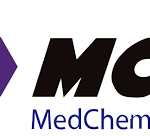Description
Angiotensin 1-7 (Ang-(1-7)) acetate is an endogenous heptapeptide from the renin-angiotensin system (RAS) with a cardioprotective role due to its anti-inflammatory and anti-fibrotic activities in cardiac cells. Angiotensin 1-7 acetate inhibits purified canine ACE activity (IC50=0.65 μM). Angiotensin 1-7 acetate acts as a local synergistic modulator of kinin-induced vasodilation by inhibiting ACE and releasing nitric oxide. Angiotensin 1-7 acetate blocks Ang II-induced smooth muscle cell proliferation and hypertrophy and shows antiangiogenic and growth-inhibitory effects on the endothelium[1][2][3].–80°C, 2 years; -20°C, 1 year (Powder, sealed storage, away from moisture)–COVID-19-anti-virus–C43H66N12O13—-[1]Gómez-Mendoza DP, et al. Angiotensin-(1-7) oral treatment after experimental myocardial infarction leads to downregulation of CXCR4. J Proteomics. 2019;208:103486.|[2]Li P, et al. Angiotensin-(1-7) augments bradykinin-induced vasodilation by competing with ACE and releasing nitric oxide. Hypertension. 1997 Jan;29(1 Pt 2):394-400.|[3]Khajah MA, et al. Anti-Inflammatory Action of Angiotensin 1-7 in Experimental Colitis. PLoS One. 2016 Mar 10;11(3):e0150861.|[4]Alzayadneh EM, et al. Angiotensin-(1-7) abolishes AGE-induced cellular hypertrophy and myofibroblast transformation via inhibition of ERK1/2. Cell Signal. 2014 Sep 19. pii: S0898-6568(14)00314-3.|[5]Janatpour ZC, et al. Subcutaneous Administration of Angiotensin-(1-7) Improves Recovery after Traumatic Brain Injury in Mice. J Neurotrauma. 2019;36(22):3115-3131.–2855063-75-9–959.06–99.87–O=C([C@H](CC1=CNC=N1)NC([C@@]([H])(NC([C@H](CC2=CC=C(C=C2)O)NC([C@@H](NC([C@@H](NC([C@H](CC(O)=O)N)=O)CCCNC(N)=N)=O)C(C)C)=O)=O)[C@H](CC)C)=O)N3CCC[C@H]3C(O)=O.CC(O)=O–Endocrinology; Inflammation/Immunology; Cardiovascular Disease–H2O : 62.5 mg/mL (ultrasonic)–Angiotensin Receptor;Angiotensin-converting Enzyme (ACE);Endogenous Metabolite–AT1 Receptor–GPCR/G Protein;Metabolic Enzyme/Protease–Peptides




 Did you check our products for animal nutrition?
Did you check our products for animal nutrition?